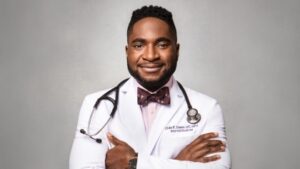
Utibe Essien, MD, MPH, Center for the Study of Healthcare Innovation, Implementation, and Policy (CSHIIP) at the Greater Los Angeles Healthcare System
LOS ANGELES — A general internist and health services researcher with the Center for the Study of Healthcare Innovation, Implementation, and Policy (CSHIIP) at the Greater Los Angeles Healthcare System, Utibe Essien, MD, MPH, has devoted his career to defining and then breaking down the systemic problems that lead to healthcare inequity. It’s a topic that has played a very real part of Essien’s life since his birth.
“I was born into health disparities. Born to a preeclamptic mother as a premature baby, and I was delivered via C-section,” he explained. “It’s far more common in Black women and Black infants in our country, and it spurred my journey into thinking about inequities in care.”
Growing up and going to medical school in New York City, he rotated through a lot of public hospitals and got to witness those inequities in care firsthand.
“I saw people who look like me and my family members who are receiving care in the public settings versus my classmates who don’t look like me getting private care,” Essien said. “When I got to Boston, where I did my residency, I really had a deeper appreciation for how there are all these factors that are outside of our control in medicine that are driving our patients’ health.”
Essien spent the next five years studying how social determinants like education, access to food and housing drove care.
This passion eventually took him to the VA, first to the Center for Health Equity Research and Promotion (CHERP) in Pittsburgh and then to CSHIIP. Even VA’s comprehensive healthcare system, which has ways to address many of those determinants, including cost of care, Essien still found inequities. His research eventually focused on what he coined “pharmacoequity”—how social determinants can impact how medication and medical technology are prescribed.
“When it comes to pharmacoequity, the big drivers I see are access, cost and bias,” Essien said. “When I think about access, I think about patients actually being able to physically get to the pharmacy. In Los Angeles, I see people coming 3 or 4 hours away from where the VA is located. … Or what if you need access to a specialist and you [have a] 9-to-5 job?”
As for cost, while VA prescription fees are a fraction of what they are in the private sector, $11 per drug can add up quickly when someone is living on disability benefits, Essien noted.
The final driver of pharmacoequity—bias—can appear in the clinic setting in a number of ways, he said. Women veterans who come in complaining of chest pain or stomach pain are more likely to be dismissed. Individuals who speak English as a second language can be perceived as less educated. And there is the still-persistent belief that Black patients experience pain differently than white patients.
One of the best ways to combat all three of these drivers is to train physicians to listen more closely to their patients—not just to their medical complaints, but the context surrounding them.
“The first thing we can all do is actually listen and hear our patients,” Essien said. “A lot of the time we ask them what brought them in, but we don’t get to hear some of the undertones that they’re sharing. We don’t get to hear about why they weren’t able to take their medications consistently. Was it because their meds were being stolen in the shelter? Was it because they were moving from hotel to hotel, and they didn’t have a refrigerator to store their insulin safely?”
Simply drawing attention to the fact that inequities exist in prescribing can be important.
“I have a lot of conversations with colleagues who are surprised that these disparities exist,” Essien revealed. “A few weeks ago I did a couple interviews with VA doctors, and they were surprised there’s a 25% deficit in Black patients getting AFib treatment [compared to white patients].”
Much of Essien’s research work has focused on racial disparities in treating atrial fibrillation (AFib), which he finds to be a “perfect model” when it comes to examining pharmacoequity. It’s the most common heart rhythm problem in the world, and blood thinners have been widely proven to be an effective method to prevent people with AFib from having strokes.
“In my opinion, it’s really understudied from a racial disparities angle,” he said. “I had a patient back in residency, one of the patients I got paged about the most. He really struggled being on the traditional blood thinner, warfarin. He had a complication, and he had a stroke. I wonder today if we’d managed to get him on the other medication if we could have prevented that stroke from happening. But there were challenges around insurance and language ability.”
While on the face of it, Essien’s work is focused on improving equitable access to medications, in his mind that’s the small-scale version of his goal.
“I hope that I can leave VA a legacy that pharmacoequity is in our policy, our structures, our practice, our research, and that VA is known for it. That we can be leaders in this space,” he said. “So [in 10 years’ time] we’re not still saying, ‘Oh it’s so weird we’re still having problems with health diversity.’ I don’t want researchers in 10 years to be writing the same papers I am.”

